You could write the most brilliant content in your industry. Your design could be flawless, your copy sharp, and your backlinks rock solid.
But if Google can’t properly access, load, or understand your website?
You’re invisible. Period.
That’s where technical SEO comes in.
Technical SEO isn’t about code for code’s sake. It’s about making sure your site is:
- Crawlable
- Fast
- Secure
- Mobile-friendly
- Structurally sound
In other words, technical SEO is how you remove obstacles between your content and Google’s ability to rank it.
And no — you don’t need to be a developer to get the basics right.
In this guide, we’re going to break down what technical SEO actually means, why it matters more than most people think, and how to spot (and fix) the silent issues that could be holding your site back — even if everything else looks perfect on the surface.
Let’s pull back the curtain.
What is Technical SEO?
Let’s get one thing straight:
Technical SEO isn’t about writing code.
It’s about making sure your website is actually usable — not just for people, but for search engines, too.
In plain English,
technical SEO is everything you do to help Google crawl, index, and understand your website without getting lost or stuck.
Think of it as the foundation and infrastructure that supports all your SEO efforts.
The Real-World Analogy
Imagine you run a brick-and-mortar store. Your products are great. Your signage is beautiful. The branding? Chef’s kiss.
But:
- The door’s locked
- The lights flicker
- There’s no clear path to the register
- And half the store is hidden behind a wall of broken shelves
That’s what a poorly optimized website looks like to Google.
Technical SEO is how you unlock the door, fix the lights, and make sure your store is ready for customers.
Because until you do that, all the content and creativity in the world won’t save you.
Why It Matters
Search engines don’t see your site the way you do.
They rely on structured signals, site architecture, and performance data to decide:
- Whether your content is accessible
- Whether it’s trustworthy
- And whether it’s worth showing to searchers
If your site is slow, confusing, or riddled with technical issues, Google’s going to move on.
Fast.
You don’t need to be a developer to understand (or benefit from) technical SEO.
You just need to know what to look for — and how to fix what’s broken.

Technical SEO Ranking Factors
When Google visits your site, it’s not just judging your words — it’s scanning how your entire site is built and structured.
Make it easy for Google to crawl, index, and rank your content!
Here are the key areas to focus on:
1. Crawlability & Indexability
This is about access. If Google can’t crawl your site, it can’t index it, and so it can’t rank it.
Key elements:
robots.txtfile: Tells search engines what pages to crawl (and what to skip)sitemap.xml: A roadmap of your site that helps search engines discover your pages- Noindex tags: Used when you don’t want a page to be indexed (but don’t overuse them)
Make sure your important pages aren’t accidentally blocked from being seen, and hide any pages that shouldn’t be crawled.
2. Site Speed & Performance
Google prioritizes fast-loading sites — especially on mobile.
Speed killers include:
- Uncompressed images
- Bloated code
- Too many third-party scripts
- Poor hosting
Use PageSpeed Insights to see how your site performs and what to fix.
3. Mobile-Friendliness
Google uses mobile-first indexing, meaning it primarily uses the mobile version of your site to determine rankings.
Check:
- Is your content easy to read on small screens?
- Do buttons and menus work well on mobile?
- Are elements spaced out for tapping?
Test your site using Google’s Mobile-Friendly Test tool.
4. HTTPS (Secure Connection)
Security is non-negotiable. Google gives ranking preference to secure (HTTPS) sites.
Make sure:
- You have an SSL certificate installed
- All HTTP versions redirect to the HTTPS version
No lock icon in the browser = bad sign for both users and search engines. (some browsers don’t show the lock anymore)
5. URL Structure & Canonical Tags
Clean, simple URLs are easier for both users and search engines to understand.
Bad: yourdomain.com/page?id=12837
Good: yourdomain.com/technical-seo-guide
Also, use canonical tags to tell Google which version of a page is the “main” one — especially if similar content exists on multiple URLs.
6. Site Architecture & Internal Linking
Your site’s layout matters. Pages should be logically organized and connected.
Tips:
- Important pages should be no more than 3 clicks from the homepage
- Use clear internal links to guide both users and search engines
- Create category structures and silo content properly
Good internal linking helps Google understand your site hierarchy.
7. Structured Data / Schema Markup
Structured data is extra info you give search engines to help them better interpret your content.
Examples:
- FAQs
- Reviews
- Products
- Events
- Local business info
Tools like Google’s Rich Results Test help you check what schema is working.
8. Fixing Broken Links & Redirect Loops
Broken links hurt UX and SEO. Redirect chains slow things down.
Use tools like:
- Ahrefs
- Screaming Frog
- Google Search Console
Clean up dead ends and unnecessary redirects to keep your crawl budget efficient.
TL;DR:
If content is what you’re saying, technical SEO is how you deliver it.
Make it easy for Google to find, load, and understand your site — and you’ll set the stage for every other SEO win.

Why Technical SEO Is a Ranking Factor
Let’s address the elephant in the server room:
Google rarely comes out and says “technical SEO = ranking factor.”
But here’s what it does say (and show):
“Pages that are fast, mobile-friendly, secure, and easy to crawl tend to perform better in search results.”
Translation?
Technical SEO absolutely impacts rankings — even if it’s not labeled with a score.
Google’s Priority: Fast, Efficient, Friction-Free Experiences
Google’s mission is to serve the best results — not just in terms of content, but also:
- Fast load times
- Clean page structure
- Mobile usability
- Security
- Proper indexing
If your site checks all those boxes? Google can deliver a better user experience. And you get rewarded for it.
What Happens When Technical SEO Is Ignored
Even the best content can be buried if:
- The page loads slowly (users bounce)
- It’s blocked by a rogue
robots.txtor “noindex” tag - The mobile version is broken
- You have duplicate content from URL parameters
- Internal links are a mess and search bots can’t navigate
In other words: your site might be alive — but invisible.
The Core Web Vitals Connection
You’ve probably heard of these:
- LCP (Largest Contentful Paint) – How fast your main content loads
- FID (First Input Delay) – How quickly your site responds to interactions
- CLS (Cumulative Layout Shift) – Does your content jump around as it loads?
Google uses these metrics to assess page quality.
Bad vitals = lower trust = weaker rankings.
Quick Technical SEO Checklist
You don’t need to be a web developer or SEO nerd to spot most technical issues.
In fact, you can catch a lot of what’s hurting your rankings with free tools and 30 minutes of focus.
Here’s a step-by-step breakdown of what you can check — today.
1. Google Search Console = Your SEO Dashboard
If you only use one tool, make it this one.
Look under:
- Coverage Report: Are pages being indexed? Any errors?
- Page Experience: Are you passing Core Web Vitals?
- Mobile Usability: Any mobile layout issues?
- Crawl Stats: Is Google regularly crawling your site?
Check this monthly — or at least after any big updates.
2. Run a Free Crawl (You’ll Learn a Lot Fast)
Use:
- Screaming Frog SEO Spider (free up to 500 URLs)
- Ahrefs Webmaster Tools (free site audit)
- Sitebulb (free trial)
These tools help you catch:
- Broken links
- Redirect chains
- Missing title tags or meta descriptions
- Duplicate content
- Orphan pages (no internal links pointing to them)
Think of this as a technical health scan for your website.
3. Test Your Mobile Friendliness
Run your URL through Google’s Mobile-Friendly Test
It’ll flag:
- Text that’s too small
- Clickable elements that are too close together
- Content wider than screen
Most of your traffic is mobile. Prioritize this.
4. Check Page Speed
Drop your homepage (and a few key service pages) into PageSpeed Insights
Pay attention to:
- LCP, FID, and CLS scores
- Opportunities to improve (image compression, font loading, code cleanup)
Slow sites hurt rankings and conversions — this tool tells you why.
5. Confirm You’re Using HTTPS
Look for the lock icon in the browser. If your site shows as “Not Secure,” that’s a red flag.
Make sure all versions of your site (www and non-www, http and https) redirect to a single, secure version.
6. Use the “Site:” Search Trick
Search site:yourdomain.com in Google.
This shows:
- What pages are currently indexed
- If weird pages (dev versions, old subdomains) are showing up
- How your title tags appear in search
Helps spot indexing issues without needing a tool.

When to Bring in a Developer or Technical SEO Specialist
The truth is you can do a lot with free tools and checklists.
But at some point, technical SEO gets… well, technical.
If your site has deeper structural issues or you’re planning big changes, bringing in a pro can save you serious time (and ranking losses).
1. You’re Dealing with a Custom CMS or Legacy Site
Custom-coded sites or outdated platforms often require developer-level changes just to fix simple things like:
- Meta tags
- Redirects
- Canonical URLs
- Mobile formatting
If updating your site feels like diffusing a bomb, it’s time to tag in help.
2. You’re Stuck in Redirect Hell
Redirect chains, loops, and mismatched slugs can confuse Google and kill load times.
A developer or technical SEO can:
- Map all redirects
- Clean up unnecessary chains
- Ensure proper 301s are in place
You want one clean, logical redirect path — not a tangled mess.
3. You’ve Got JavaScript Rendering Issues
If your site relies heavily on JavaScript (think: modern single-page apps or complex page builders), Google might not be seeing all your content.
A pro can:
- Audit how content loads
- Implement server-side rendering or dynamic rendering
- Ensure your key content is crawlable
If Google can’t render it, it can’t rank it.
4. You’re Doing a Site Migration or Redesign
Changing domains? Switching CMS platforms? Rebuilding your site?
This is prime time for SEO disasters (lost rankings, broken URLs, deindexed pages).
A technical SEO can:
- Create a redirect map
- Preserve link equity
- Monitor indexation during the launch
Never launch a new site without a migration strategy.
5. You’re Seeing Technical Errors in Search Console You Don’t Understand
If you’re getting error codes like:
- “Crawled – currently not indexed”
- “Duplicate without user-selected canonical”
- “Page with redirect”
…and you’re not sure what they mean or how to fix them?
Bring in someone who speaks Google’s language. It’ll save you hours.
Final Word
Technical SEO isn’t glamorous.
It won’t trend on social. It doesn’t come with flashy graphics or viral clicks.
But it quietly makes or breaks your entire SEO strategy.
This is the groundwork that ensures:
- Google can access your content
- Visitors can navigate your site
- Your rankings can actually grow — and stick
So don’t ignore it.
Fix the leaks, clean up the code, and give your site the structure it deserves.
Because once your technical SEO is solid, everything else you do will work harder for you.
New to seo ? Check this article out: seo beginner guide.
FAQs
1. What is technical SEO, exactly?
It’s the part of SEO that focuses on how your website is built — making sure Google can crawl, index, and understand your site without issues.
2. Do I need to know how to code to do technical SEO?
Not at all. Many fixes can be done using tools, plugins, and help from a developer when needed. You just need to know what to look for.
3. How often should I audit my technical SEO?
At least once per quarter, or anytime you make major changes (new pages, redesign, CMS switch, etc.).
4. Does technical SEO really affect rankings?
Yes — indirectly and directly. If your site is slow, confusing, or broken, Google will crawl and rank it less often. Solid technical SEO ensures your content has a chance to compete.
5. What’s the best free tool to get started?
Google Search Console — hands down. It shows crawl errors, mobile usability issues, indexing problems, and more.
Pair it with PageSpeed Insights and a free crawl from Screaming Frog, and you’ve got a solid starter setup.

